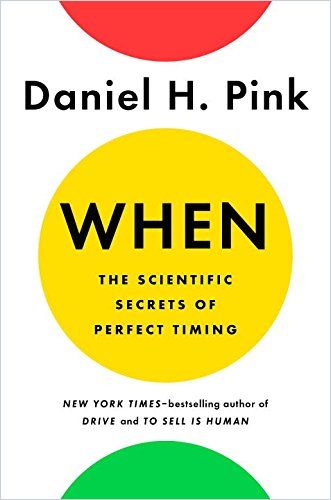To Daniel Pink, timing is an art and a science.

The “When-To” List
Daniel H. Pink makes a compelling argument that timing is everything as he examines the role that time plays in human interactions. A large existing body of work already evaluates how to address projects, trends and issues. This book launches what Pink calls a new genre of “when-to” books. He delves into the science of timing and taps into research from various fields. He presents a valuable analyses as he addresses the time-related factors that affect people’s daily habits. He discusses the importance of “beginnings, midpoints” and “endings” and the role of timing in group dynamics.
Across continents and time zones, as predictable as the ocean tides, was the same daily oscillation – a peak, a trough and a rebound.Daniel H. Pink
Pink, the New York Times bestselling author of A Whole New Mind, Drive and to Sell is Human, complements each chapter with a “Time Hacker’s Handbook.” This addition offers worthwhile exercises to help readers incorporate his when-to concepts into their personal and professional worlds.
“Timing is everything.”
Pink offers valuable lessons about why it matters to give questions about when-to act as much consideration as you give questions of how to. He builds his book around the central premise that timing affects the choices everyone makes regularly. Whether to focus on a person or project, to marry, to change jobs, to share good or bad news, or simply to go for a run are all types of “when decisions.”
Though timing is everything, most people make these decisions based on guesswork or intuition instead of deliberate consideration. People often treat timing as an art, but Pink provides research and case studies demonstrating that timing is actually a science. He draws on findings from varied disciplines – anesthesiology, anthropology, endocrinology, chronobiology, economics, social psychology, and more – to provide insight into how better timing can help people work smarter and improve their lives.
Beneath the surface of our everyday life is a hidden pattern: crucial, unexpected and revealing.Daniel H. Pink
To incorporate these ideas into your life, Pink advises, begin considering decisions based on “when-to” questions, rather than the how-to perspective prevalent in most time-management methods. With this new when-to strategy in mind, you may gain a better grasp on how the divisions of time within a day, project, career or lifetime create a framework and can lead to meaningful consequences.
Beyond individual implications, Pink demonstrates that timing is a component of how people coordinate with each other in group settings. Synchronicity plays a role in managing complex team interactions as well as projects. Pink demonstrates that even languages convey elements of time in the way they uniquely express meaning about the past, the present and the future. In so doing, each language reflects how the people who speak it think about history, behave economically or record the routine minutes of their days.
Your biological clock
Daily rhythms define how most people experience waking life. All living organisms have biological clocks that control their circadian rhythms.The suprachiasmatic nucleus, a cluster in the human brain’s hypothalamus, regulates the body’s temperature fluctuations, controls hormones and helps run sleep cycles. Pink argues that the daily contours of time are similar and predictable from person to person, but, of course, people don’t all follow the same patterns.
“Hidden patterns”
For about 75% of people, the hidden pattern of each day manifests in three stages: “peak, trough and rebound.” For others, the order may reverse.Your chronotype, or personal circadian rhythm, defines how you live out this pattern. To identify your chronotype, check Pink’s “Time Hacker’s Handbook” sections in the book’s early chapters. He explains that a person’s “positive affect” – shown through emotions like alertness, confidence and enthusiasm –indicates his or her peak time. This level of engagement tends to appear in the morning, plummet during the afternoon trough and rebound as evening approaches.
Each of us has a chronotype – a personal pattern of circadian rhythms that influences our physiology and psychology.Daniel H. Pink
Feelings of happiness, warmth and enjoyment follow these patterns. Conversely, emotions like anger and guilt indicate a “negative affect.” When your alertness and energy fall, so do your abilities to analyze, focus and constrain inhibitions. Pink draws on research showing that bad timing can cause a performance dip comparable to drinking alcohol at the legal limit.
Take a break
The afternoon trough typically occurs about seven hours after waking.Pink argues that the trough is so dangerous it can turn your afternoon into the Bermuda Triangle of each day. He advises taking “vigilance breaks” and “restorative breaks,” which he sees as safety measures as well as respites. Even seemingly straightforward breaks, like napping or eating a good lunch away from your desk, can provide opportunities to refresh yourself that will boost you mentally and physically.
Each day, alongside your list of tasks to complete…make a list of the breaks you’re going to take.Daniel H. Pink
Vigilance breaks provide a pause before you move into a high-stakes moment. For example, in a surgical suite, pausing to work through a pre-op checklist to make sure that everything is correct can help improve care and reduce complications. Restorative breaks are short pauses that help avoid the trough’s dangers, guard against “cognitive fatigue” and improve performance.
Pink doesn’t define a single, perfect break, but he states that “something beats nothing.” That is, being active beats remaining stationary, being with others beats being alone, going outside beats staying indoors, and finding time to detach fully from your current task beats multitasking. Pink advises that when you take a break, take a real one: Don’t answer texts or do anything that relates to work.
“Beginnings” matter.
Pink argues that beginnings play a greater role than most people understand. The quality of a start can affect individual outcomes – how well a day at school goes, how well a career launches and how well systems function. Be awake to the power of each start, and try to make strong beginnings. If a start fails, try to launch a “fresh start.” And when the launch spins out of control, Pink advises working with others to attempt a “group start.”
“Midpoints” matter.
Pink says midpoints have “powerful, though peculiar, effects” on what people choose to do and how they do it. Reaching the midpoint – of life, of a project, of a school term, a ball game – can stall progress or stimulate it. Midpoints can be alarm clocks that motivate you at moments when you’re behind in your desired progress toward your goals.
When we reach a midpoint, sometimes we slump, but other times we jump.Daniel H. Pink
If you know that your standards may slump in the middle of a project, make preparations to manage the consequences. A midpoint is a signal that you have used half the time allocated for a project – or at midlife, half your lifespan. This marker may provide a healthy injection of energy to revive your motivation and reshape your strategy.
And “endings” matter
Pink shares evidence that people have a strong preference for happy endings. They prefer sequences of events that rise, not fall. People tend to judge events – meals or vacations, for example – by specific moments, particularly at the end, rather than by the entire experience. Being aware of how people “register, rate and recall experiences” has implications for understanding human behavior.
At the beginning of a pursuit, we’re generally more motivated by how far we’ve progressed; at the end, we’re generally more energized by trying to close the small gap that remains.Daniel H. Pink
Ultimately, endings reveal that the pursuit of meaning is an essential facet of the human condition. “Poignancy,” a complex emotion mixing happiness and sadness, is at the center of each meaningful conclusion. Pink encourages readers to remember that while endings may obscure your memory or cloud your perceptions, they also can elevate and energize you and move you closer toward a goal.
In the Pink
Daniel Pink always strives to be ahead of the curve of popular opinion and then to generate it. Here, he succeeds. Despite his characteristic habit of using multiple sentences when one would suffice, he raises fascinating conclusions about human nature and patterned human behavior. Pink sought out and presents compelling research to support each of his conclusions. Without venturing into less purely concrete territory, like meditation or mindfulness, Pink provides a primer about being more mindful of your body, emotions and mental habits around the clock. His guide works well for those who’d like to improve the flow of their days, projects, work and personal schedules, and for managers who want to boost productivity and workplace satisfaction.





